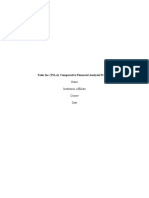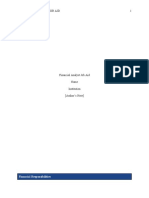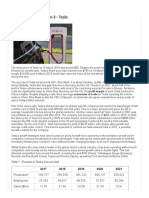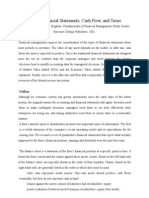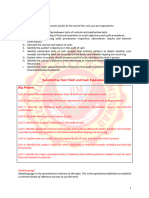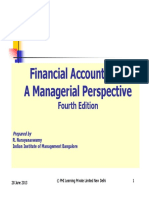Analyzing Financial Statements: Common-Size Presentation, Trends, and Tesla Motors’ Cash Flow
Position
Understanding financial statements is essential for evaluating an organization’s performance, growth
potential, and financial stability. Analysts and stakeholders rely on common-size statements, trend
analysis, and ratio benchmarking tools to gain deeper insights into a company’s operations. Additionally,
the statement of cash flows plays a central role in understanding cash generation and usage. This essay
explores the importance of common-size financial statements, explains why trends are often more
meaningful than single-year data and analyzes Tesla Motors Inc.’s statement of cash flows to assess its
financial health.
Common-size financial statements are valuable for simplifying financial data and facilitating
comparisons. In traditional financial statements, dollar amounts vary significantly between companies of
different sizes, making it challenging to compare their financial health directly. To address this, common-
size financial statements express each line item as a percentage of a base figure, such as total revenue on
the income statement or total assets on the balance sheet. Common-size statements allow analysts to
compare companies with varying revenues, assets, or expenses by eliminating scale differences. For
instance, Tesla’s operating expenses as a percentage of total revenue make it easier to compare its cost
structure to that of other automakers, regardless of their absolute revenue levels.
This type of presentation also simplifies the identification of financial trends. If Tesla reports that 30% of
its revenue is spent on operating costs one year but reduces it to 25% the next, this signals improved
cost management. Similarly, common-size balance sheets highlight whether a company’s assets are
growing relative to liabilities. The ability to detect such relationships makes common-size analysis more
meaningful than dollar figures alone, which often obscure the underlying financial dynamics.
Trend analysis adds another layer of insight by examining financial data over multiple periods rather than
focusing solely on a single year. Financial statements for one year provide a snapshot of a company’s
performance but lack the historical context needed to interpret long-term patterns. For example, a sharp
decline in Tesla’s revenue in one year might seem alarming in isolation, but a broader analysis of trends
could reveal that the company’s revenue has consistently grown over the last five years. Such patterns
are critical for making informed decisions, as they distinguish temporary setbacks from systemic issues.
Furthermore, trend analysis is vital for forecasting future performance. Investors, lenders, and managers
use historical trends to predict a company’s trajectory. For instance, if Tesla’s cash flow from operations
has shown steady growth over several years, it signals strong operational health and the ability to sustain
future investments. Conversely, recurring negative trends such as declining profit margins or increasing
debt are early warning signs of financial trouble.
Long-term trends also help evaluate management effectiveness. If Tesla consistently reduces its
operating expenses as a percentage of revenue while increasing production capacity, it indicates
improved efficiency and effective leadership. In contrast, short-term performance fluctuations may
reflect external factors, such as economic conditions or market disruptions, rather than fundamental
financial issues. Trend analysis ensures stakeholders consider the bigger picture when evaluating a
company’s performance.
�The statement of cash flows is another critical component of financial analysis, as it reveals how a
company generates and uses cash. Tesla Motors Inc.’s statement of cash flows offers insights into the
company’s cash position, particularly the difference between operating cash flow and its net loss. At first
glance, Tesla’s reported net loss may appear concerning; however, a closer examination of cash flow
from operating activities tells a different story.
The discrepancy between Tesla’s operating cash flow and net loss arises primarily due to non-cash
expenses and changes in working capital. Net income, calculated using accrual accounting, includes
items like depreciation, amortization, and stock-based compensation, which reduce profits but do not
involve actual cash outflows. For instance, Tesla reported significant depreciation and amortization
expenses in its financial statements, reflecting investments in production facilities and equipment.
Similarly, while reducing reported earnings, stock-based compensation expenses do not affect the
company’s cash position. These non-cash adjustments explain why Tesla’s cash flow remains positive
despite a net loss.
Changes in working capital also improve Tesla’s cash flow. An increase in accounts payable and accrued
liabilities allows Tesla to defer cash outflows, temporarily enhancing its operating cash flow. This
highlights the importance of analyzing cash flow separately from net income, providing a clearer picture
of a company’s ability to generate cash from core operations.
In addition to operating cash flow, Tesla’s financing activities reveal its approach to managing debt and
liquidity. Tesla has repaid portions of its outstanding debt while raising capital through stock issuances.
This dual strategy reflects the company’s efforts to strengthen its balance sheet and maintain financial
stability. By issuing stock in public offerings, Tesla secured substantial funds without overburdening itself
with additional debt. Although this approach dilutes existing shareholders’ ownership, it provides the
liquidity needed to fund operations and repay obligations.
Tesla’s ability to balance debt repayment with strategic investments demonstrates its long-term growth
priorities. A significant portion of Tesla’s cash outflows from investing activities can be attributed to
investments in property, plant, and equipment (PPE). These investments are essential for expanding
production capacity, particularly as demand for electric vehicles continues to rise globally. While such
expenditures reduce short-term cash reserves, they position Tesla for sustained growth and
competitiveness in the electric vehicle market.
The overall improvement in Tesla’s cash flow position highlights the company’s operational resilience and
financial strength. Over time, Tesla’s cash flow from operations has shown consistent growth, driven by
increased revenue and improved cost management. This positive trend signals that Tesla is generating
sufficient cash to support its operations, repay debt, and invest in growth initiatives. Additionally, the net
increase in cash and cash equivalents reflects the company’s strong liquidity position, which is crucial for
navigating market uncertainties and funding future expansion.
Analyzing Tesla’s statement of cash flows within the broader context of its financial performance
underscores the importance of trend analysis and cash flow metrics. While net income provides valuable
insights into profitability, cash flow analysis offers a more accurate measure of a company’s ability to
sustain operations and investments. Tesla’s ability to generate positive operating cash flow, manage its
debt obligations, and invest in growth initiatives demonstrates its financial health and strategic focus.
�In conclusion, presenting financial statement information in common-size terms simplifies comparisons
and highlights critical financial relationships. By expressing line items as percentages, common-size
analysis allows stakeholders to identify trends, evaluate cost structures, and benchmark performance
against competitors. Trend analysis further enhances financial evaluation by providing long-term insights
and distinguishing temporary setbacks from systemic issues. The case of Tesla Motors Inc. illustrates how
operating cash flow, debt management, and liquidity improvements are key indicators of financial
resilience. While Tesla’s net loss may initially raise concerns, its positive cash flow position and strategic
investments reflect a strong foundation for future growth. By integrating common-size analysis, trend
evaluation, and cash flow metrics, stakeholders can comprehensively understand a company’s financial
health and long-term prospects.






























